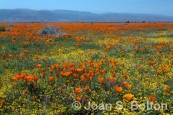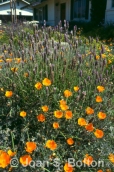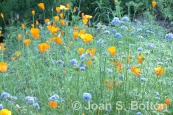
What’s not to love about California poppies?
They’re exuberant, abundant and just the right degree of brightness, with the tips of their brilliant orange petals flaring upward and the bases of their flowers gently grazing the top wisps of bluish-gray foliage. On sunny days, the flowers appear as many cups of glowing gold.
In the wild the effect is magnified, creating a luminous carpet that stretches across the land, whether mixed with blue and white lupine on Figueroa Mountain, appearing as low, wind-swept drifts in the Carrizo Plain, interspersed with tiny goldfields wildflowers in the Antelope Valley California Poppy Reserve or simply popping up at random in the median on Highway 101.
Fortunately California poppies are equally at home in the garden, and are especially easy to grow on the Central Coast. Now is the time to sow poppies in your own yard, whether to mimic a vast sweep, weave through existing plantings or just create a patch of color.
Getting Started

In nature, California poppies (Eschscholzia californica) flourish in open, grassy areas.
They begin to sprout in fall and winter, with the onset of cooler temperatures and the first winter rains, then bloom most heavily in March, April and May. Thanks to our early rain this year, scattered plants in my garden are already up and growing.
Poppies also thrive in poor, disturbed soil. That’s why you’ll spot fresh, dense stands in road cuts along highways or in burn areas.

In the garden, select a sunny spot, pull any weeds, then rough up the soil with a stiff rake. Don’t add amendments or otherwise try to improve the bed. If it’s too rich, your poppy plants will become big, soft and likely fall over.
Scatter the seeds, which look like tiny black balls. Some folks first mix the seeds with a handful of sand so that they’re easier to broadcast evenly. But that’s not absolutely necessary. Cover the seeds with a sprinkling of topper or other loose, fine-textured organic material. The trick is to make sure that the cover is not too thick. Any more than one quarter to half an inch of material may wreak havoc with germination.

Gently water the area. Then, if the rains cooperate, you’re done.
Otherwise, keep the bed moist by sprinkling a few times a week with a hose. Your first ferny leaves should sprout within a few weeks and by the end of February, the first blooms may appear.
However, depending on what happens weather-wise, you may not see much action until spring. Germination times can vary by weeks or even months, which is why poppies bloom in waves in nature, too.
Ongoing Care

Stay on top of weeding. That same raking that disturbed the soil may bring up dormant weed seeds, which are all too happy to try to out-compete your poppies.
Water the bed every few weeks, if there’s no rain.
Individual poppy plants may bloom for several months or more, with their leaf color shifting toward gray and their flowers shrinking in size as summer approaches.
As they drop their petals and begin to go to seed, their stems will elongate and their centers will flop apart. While California poppies are often labeled as annuals, some plants can last a couple of years on the Central Coast.

You can encourage that longer life by cutting back the spent plants to within a few inches of their centers, rather than yanking them out by their long tap roots. Within a few weeks, new, bluish-gray foliage may sprout from the crown.
Due to our mild climate, plants may go through several cycles of blooming, resting and resprouting, even if they don’t survive until the following year.

I tend to not do anything to my declining poppies until their long, skinny seed pods have dried and begun to split open, exposing rows of round, little seeds.
I could wait until the pods pop all on their own, sending the seeds hither and yon. Instead, I put on boots and stomp through the plants, pods and all, to disperse the seeds within the bed for next year’s crop. I wait a week, then trim back the plants to their centers and clean up the debris.
Toward the end of summer, I’m never sure which lingering plants are last year’s carry-overs or this year’s late-comers. Nonetheless, the technique ensures that I have a new round of poppies blooming every year in my garden.
≈
Fun Facts About California Poppies

While there are some 200 species of poppies, only the California poppy bears a rim on the flat, circular receptacle that sits at the base of its flowers where the petals attach to the stem.
It’s easy to see the rim — it happens to be pink — after the petals fall off. From this little platform, the ovary, brimming with seeds, swells into an upright cone, then flattens, curls, dries up and pops out mature seeds.
Most California poppies bear only four petals per flower; a few rarities bear six or eight.

California poppies are our state flower for good reason: they thrive throughout California, from the coast to interior valleys, and from sand dunes to rocky hillsides. They extend north into Oregon and Washington, east toward the Colorado Desert, Arizona and New Mexico, and south into Mexico. They are so adaptable that they’ve even naturalized in Australia and India.
With such widespread distribution, there is much variability in height, width, foliage and flower color.
Indeed, the botanic name, Eschscholzia californica, serves as a catch-all for what botanists have determined are eight to 12 species or subspecies. Hybridizers have also created some frilly, multi-colored versions, but they don’t have the same wild, natural appeal.

Regardless of their differences, all California poppies close at night and on cloudy days.
Hormones sensitive to sunshine govern the opening and closing by regulating and adjusting fluid pressure within the petals.
The petals unfurl with daylight, their bright orange coloring serving as a beacon to nectar-seeking insects, including fat bumblebees that dust themselves with golden pollen as they methodically move from one cup to the next.
The flowers close tightly at night, encasing and protecting the reproductive organs — the pistils, which contain egg cells, and the stamens. At times, insects are caught inside. But the overnight stays don’t seem to harm the insect or the flower.
≈
Seeds of Wisdom
Grow your California poppies from seed, and sow the seed directly where you’d like your poppies to be. They are difficult to transplant because they quickly send down an orange tap root that looks like a carrot and dives into the earth 4 to 6 inches or more.
≈
Copyright, Joan S. Bolton. All rights reserved. Reproduction of text or photos in any form is prohibited without written permission.
≈
